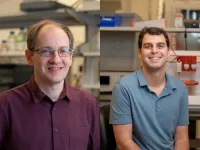(Press-News.org) MSU has a satellite uplink/LTN TV studio and Comrex line for radio interviews upon request.
EAST LANSING, Mich. – Reforestation efforts to restock depleted forests are important for addressing climate change and for both capturing and restoring carbon from the Earth’s atmosphere. These types of solutions to mitigate carbon emissions are critical after 2023 proved to be the warmest year on record. However, some models have been found to be inaccurate.
New research from Michigan State University has found the carbon removal potential of some reforestation models have been over exaggerated — and not by a small factor — but by as many as three times of a factor. The goal set by the Paris Agreement in 2015 for countries to limit their global warming to 1.5 degrees is now close to being surpassed.
Runsheng Yin is a professor in the Department of Forestry in the College of Agriculture and Natural Resources, where he specializes in the evaluation of ecosystem services, ecological restoration and general natural resource economics and policy. Yin has published new research identifying that carbon-capture models have not factored in what happens to the timber after trees are logged.
“The climate crisis is heightening, with 2023 representing the warmest year on record,” Yin said. “Nature-based solutions have an important role to play in helping us stem the worst impacts of climate change — but rigorously assessed methods to reliably offset and reduce greenhouse gas emissions could not be more urgent. As the practice becomes increasingly monetized, it is crucial that the accounting is done accurately.”
Yin examined a pine field in the Southern United States that is managed quite intensely. People or businesses can receive carbon credits when they reduce, avoid or remove greenhouse gas emissions.
He found that the amount of carbon offset credits a landowner can receive is exaggerated by a factor of at least 2.76, indicating the carbon reduced is not as efficient as previously thought. This research indicates that this overcalculation represents forestation beyond that pine field.
Specifically, the amount of time it takes for carbon to return to the atmosphere post-logging can differ depending on different wood products, whether that is paper, plywood or furniture. These types of wood degrade at different rates, and carbon must be stored for a specific time period for credits to be earned.
Alternatively, there also can be an issue when forests are kept intact, since people do not always consider the holding costs and the ability to use wood in lieu of fossil fuels, according to Yin.
“My research shows that its potential may not be as great as some analysts have claimed,” said Yin, when referring to carbon capturing. “That’s because existing studies have largely failed to conform to the accounting principles of the Paris Agreement, treat timber and carbon as joint products appropriately and consider how long each of the resulting wood products will store its carbon.”
The finding signals the need for more accurate and specific assessments for carbon storage, specifically, calculating the amount of time carbon that’s stored in wood products will last before returning to the atmosphere.
Forests will continue to play an important role in carbon sequestration, and companies should be encouraged to invest in reforestation to minimize carbon emissions — including receiving financial incentives.
Therefore, Yin recommends strengthening national and international efforts and even creating necessary programs to handle the assessment of carbon capturing. His research warns that it will not be enough to remove the amount of carbon created in timber, and these actions — which are so important — must receive the proper jurisdiction and evaluation of their effectiveness.
Read on MSUToday.
###
Michigan State University has been advancing the common good with uncommon will for more than 165 years. One of the world’s leading public research universities, MSU pushes the boundaries of discovery to make a better, safer, healthier world for all while providing life-changing opportunities to a diverse and inclusive academic community through more than 400 programs of study in 17 degree-granting colleges.
For MSU news on the web, go to MSUToday or twitter.com/MSUnews.
END
New MSU research: Are carbon-capture models effective?
2024-05-03
ELSE PRESS RELEASES FROM THIS DATE:
One vaccine, many cancers
2024-05-03
Acute myeloid leukemia (AML) is a type of blood cancer that forms in the soft marrow of the bones, typically attacking cells that would otherwise form the key component of the body’s immunodefense system, white blood cells.
In a new study published in Blood Advances, researchers from the UChicago Pritzker School of Molecular Engineering’s Hubbell Lab created with a novel approach to develop in-situ cancer vaccines that could increase the effectiveness of immunotherapies in AML and other blood ...
nTIDE April 2024 Jobs Report: Post-pandemic gains seen in employment for people with disabilities appear to continue
2024-05-03
East Hanover, NJ – May 3, 2024 – Following a two-month decline, the employment of individuals with disabilities returns to near historic highs reported by nTIDE in late 2023, reaffirming the significance of those prior highs. That’s according to today’s National Trends in Disability Employment – semi-monthly update (nTIDE), issued by Kessler Foundation and the University of New Hampshire’s Institute on Disability (UNH-IOD).
Month-to-Month nTIDE Numbers (comparing March 2024 to April 2024)
“Following two months of decline, individuals with disabilities are now edging back towards their near ...
Exploring oncogenic driver molecular alterations in Hispanic/Latin American cancer patients
2024-05-03
“[...] this editorial underscores the complex molecular diagnosis landscape of cancer in the [Latin American] population.”
BUFFALO, NY- May 3, 2024 – A new editorial paper was published in Oncoscience (Volume 11) on April 22, 2024, entitled, “Exploring oncogenic driver molecular alterations in Hispanic/Latin American cancer patients: A call for enhanced molecular understanding.”
In this new editorial, researcher Rafael Parra-Medina from Fundación Universitaria de Ciencias de la Salud and Instituto Nacional de Cancerología begins by discussing Latin America’s (LA) population — a heterogeneous mix ...
Hungry, hungry white dwarfs: solving the puzzle of stellar metal pollution
2024-05-03
Dead stars known as white dwarfs, have a mass like the Sun while being similar in size to Earth. They are common in our galaxy, as 97% of stars are white dwarfs. As stars reach the end of their lives, their cores collapse into the dense ball of a white dwarf, making our galaxy seem like an ethereal graveyard.
Despite their prevalence, the chemical makeup of these stellar remnants has been a conundrum for astronomers for years. The presence of heavy metal elements—like silicon, magnesium, and calcium—on the surface of many of these compact objects is a perplexing ...
New study reveals how teens thrive online: factors that shape digital success revealed
2024-05-03
A new study co-authored by Sophie Janicke-Bowles, associate professor in Chapman University’s School of Communication, sheds light on the role that new and traditional media play in promoting and affecting character development, emotions, prosocial behavior and well-being (aka happiness) in youth.
Her research and teaching focus on positive psychology, media and new communication technologies, and media and spirituality. The study, published April 13 in Society for Research in Child Development (SRCD), investigates how adolescents perceive ...
U of T researchers discover compounds produced by gut bacteria that can treat inflammation
2024-05-03
Researchers at the University of Toronto have found naturally occurring compounds in the gut that can be harnessed to reduce inflammation and other symptoms of digestive issues. This can be achieved by binding the compounds to an important, but poorly understood, nuclear receptor.
The gut microbiome hosts bacteria that produce compounds as by-products of feeding on our digestive remnants. The compounds can bind to nuclear receptors, which help transcribe DNA to produce proteins and non-coding RNA segments.
By identifying ...
Aligned peptide ‘noodles’ could enable lab-grown biological tissues
2024-05-03
HOUSTON – (May 3, 2024) – A team of chemists and bioengineers at Rice University and the University of Houston have achieved a significant milestone in their work to create a biomaterial that can be used to grow biological tissues outside the human body. The development of a novel fabrication process to create aligned nanofiber hydrogels could offer new possibilities for tissue regeneration after injury and provide a way to test therapeutic drug candidates without the use of animals.
The research team, led by Jeffrey Hartgerink, professor of chemistry and bioengineering, has developed peptide-based hydrogels that mimic the aligned structure of muscle and ...
Law fails victims of financial abuse from their partner, research warns
2024-05-03
Victims of financial abuse from their partner in England and Wales are being failed by an “inadequate” legal response, new research warns.
Coerced debt causes considerable harm. People often live with the effects of being forced to give money or take out loans or credit cards long after the abusive relationship has ended.
Using the law to tackle it is more complex than other forms of abuse because to be free of the harmful effects of the abuse people’s contractual liability for the debt may need to be set aside. The law often favours lenders, who have little obligation to ensure that transactions are free from coercion.
New research recommends ...
Mental health first-aid training may enhance mental health support in prison settings
2024-05-03
According to Rutgers Health researchers, training correctional officers in Mental Health First Aid (MHFA) for adults, a 7.5-hour national education program from the National Council of Mental Wellbeing, may help provide them with the necessary skills to effectively identify signs and symptoms of mental distress and advocate for incarcerated individuals facing mental health crises.
Led by Pamela Valera, an assistant professor in the Department of Urban-Global Public Health at Rutgers School of Public Health, ...
Tweaking isotopes sheds light on promising approach to engineer semiconductors
2024-05-03
Research led by scientists at the Department of Energy’s Oak Ridge National Laboratory has demonstrated that small changes in the isotopic content of thin semiconductor materials can influence their optical and electronic properties, possibly opening the way to new and advanced designs with the semiconductors.
Partly because of semiconductors, electronic devices and systems become more advanced and sophisticated every day. That’s why for decades researchers have studied ways to improve semiconductor compounds to influence how they carry electrical current. One approach is to use isotopes to ...





